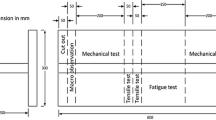Abstract
The ultimate load-bearing capacity of typical fillet welded joints made of ultra high-strength steel (UHSS) S960 has been investigated. The aim of the work has been to assess the validity of current design rules for UHSS and possibly define new design criteria. Experimental testing and nonlinear finite element analysis (FEA) were applied to define the capacity of fillet welded joints. Joint geometries and material properties were measured for both filler and base materials. In comparison with current design rules, the experimental results showed that the fillet welded joints had adequate load-carrying capacity presuming that adequate weld quality is achieved in the joint fabrication. Load-carrying capacities and rupture modes in welds defined by FEA were in agreement with experimental results. The experimental deformation capacities of some of the joints were found to be critical, but the capacities can be improved by the use of undermatched filler metals. Heat input control is essential in the fabrication of welded connections made of UHSS and thus an additional failure criteria should be considered in design codes due to the softening effect in HAZ.
Similar content being viewed by others
References
EN 1993-1-8, Eurocode 3: Design of steel structures — Part 1-8: Design of joints, 2005.
EN 1993-1-12, Eurocode 3: Design of steel structures — Part 1-12: Additional rules for extension of EN 1993 up to steel grades S 700, 2007.
Kuhlmann U., Günther H.-P. and Rasche C.: High-strength steel fillet welded connections, Steel Construction, Design and Research, 2008, vol. 1, no. 1, pp. 77–84.
Günther H.-P., Hildebrand J., Rasche C., Versch C., Wudtke I., Kuhlmann U., Vormwald M. and Werner F.: Welded connections of high-strength steels for building industry, Doc. IIW 2096, to be published in Welding in the World, 2012, vol. 56, no. 5/6.
Collin P. and Johansson B.: Design of welds in high-strength steel, 4th European Conference on Steel and Composite Structures, Maastricht, 2005.
Toivonen J.: Static strength of fillet welded joint made of ultra high-strength steel, Master’s Thesis, Lappeenranta University of Technology, 2010 (in Finnish).
Nevasmaa P., Karjalainen-Roikonen P., Laukkanen A. and Kuoppala J.: Ultralujan, suorakarkaistun Optim 960 QC ohutlevyteräksen lujuusja sitkeyskäyttäytyminen, The strength and ductility behaviour of direct hardened, ultra high-strength Optim 960 QC steel, Hitsaustekniikka 3/2010, 2010 (in Finnish).
Pirinen J.: Optimization of pulsed-MAG -process for ultra high-strength steels, Master’s Thesis, Lappeenranta University of Technology, 2006 (in Finnish).
Karppi R. and Leiviskä P.: Keinoja parantaa ultralujan teräksen hitsausliitoksen staattista lujuutta ja väsymiskestävyyttä pulssi MAG hitsauksen avulla, Methods to improve the static and fatigue strength of welded joint using MAG and pulsed — MAG-processes, Research Report No VTT-R-04809-08, VTT, Espoo, 2008 (in Finnish).
NX Nastran 6 Release Guide, Siemens Product Lifecycle Management Software Inc., 2008.
Author information
Authors and Affiliations
Corresponding author
Rights and permissions
About this article
Cite this article
Björk, T., Toivonen, J. & Nykänen, T. Capacity of Fillet Welded Joints Made of Ultra High-Strength Steel. Weld World 56, 71–84 (2012). https://doi.org/10.1007/BF03321337
Published:
Issue Date:
DOI: https://doi.org/10.1007/BF03321337




